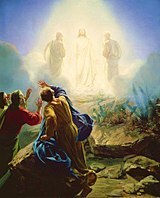
First Reading Genesis 15:5-12,17-18
God makes a covenant with Abraham, promising him many descendants.
Responsorial Psalm Psalm 27:1,7-8,8-9,13-14
A prayer to God who is our salvation
Second Reading Philippians 3:17-4:1 (or shorter form, Philippians 3:20-4:1)
Paul encourages the Philippians to remain firm in their faith that Christ will subject all things to himself.
Gospel Reading
Luke 9:28b-36
Jesus is transfigured in the presence of Peter, John, and James.
Background on the Gospel Reading
On the second Sunday of Lent, we move from Jesus' retreat to the desert and temptation by the devil to the glory shown in Jesus' Transfiguration. On the first Sunday of Lent, our Gospel always tells the story of Jesus' temptation in the desert. On the second Sunday, we always hear the story of Jesus' Transfiguration.
The report of Jesus' Transfiguration is found in each of the Synoptic Gospels—Matthew, Mark, and Luke. The context for Luke's Transfiguration story is similar to that found in both Matthew and Mark. The Transfiguration occurs after Peter's confession that Jesus is the Messiah and Jesus' prediction about his Passion. After the prediction there is a discussion of the cost of discipleship in each of these Gospels. The placement of the Transfiguration story close to Peter's confession and Jesus' prediction encourages us to examine the Transfiguration in the larger context of the Paschal Mystery.
The Transfiguration occurs on a mountain in the presence of just three of Jesus' disciples—Peter, James and John. These are among the first disciples that Jesus called in Luke's Gospel. We recently heard this Gospel at Mass, on the fifth Sunday in Ordinary Time. Only Luke's Gospel, which often describes Jesus at prayer, indicates that Jesus is praying as his appearance changes to bright white. Luke indicates that the three disciples were sleeping while Jesus prayed. They will be sleeping again as Jesus prays in the Garden of Gethsemane before his Passion and death.
As they awake, Peter and the disciples see Jesus Transfigured and Elijah and Moses present with Jesus. Elijah and Moses, both significant figures in the history of Israel, represent Jesus' continuity with the Law and the Prophets. In Matthew's and Mark's Gospels, there is reference to conversation among Jesus, Elijah, and Moses, but only Luke's Gospel explains that this conversation is about Jesus' later accomplishments in Jerusalem. Luke describes this as his exodus, connecting Jesus' Passion, death, and Resurrection with the Israel's Exodus from Egypt.
On witnessing Jesus' Transfiguration and seeing Jesus with Elijah and Moses, Peter offers to construct three tents for them. Having just awoken, perhaps Peter's offer was made in confusion. We also notice that Peter reverted from his earlier confession that Jesus is the Messiah, calling Jesus “master” instead. As if in reply to Peter's confusion, a voice from heaven speaks, affirming Jesus as God's Son and commanding that the disciples listen to him. This voice from heaven recalls the voice that was heard at Jesus' baptism which, in Luke's Gospel, spoke directly to Jesus as God's Son.
In his Transfiguration, we see an anticipation of the glory of Jesus' Resurrection. In each of the reports of the Transfiguration, the disciples keep secret what they have seen. Not until they also witness his Passion and death will the disciples understand Jesus' Transfiguration. We hear this story of Jesus' Transfiguration early in Lent, but we have the benefit of hindsight. In our hearing of it, we anticipate Jesus' Resurrection even as we prepare to remember Jesus' Passion and death.
No comments yet. Be the first to say something!